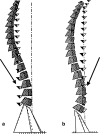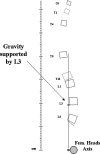Gravitational forces and sagittal shape of the spine. Clinical estimation of their relations
- PMID: 17653545
- PMCID: PMC2898950
- DOI: 10.1007/s00264-007-0421-y
Gravitational forces and sagittal shape of the spine. Clinical estimation of their relations
Abstract
The sagittal morphology of the pelvis determines the amount of lordosis needed for each individual. The proper harmony of the sagittal spinal curves allows a stable balance, economical in terms of mechanical effects and muscular energy. A previous barycentremetrical laboratory study allowed us to demonstrate that the axis of gravity of the upper body segment was located behind the lumbar vertebrae and the femoral heads, thus ensuring economy and stability. The determination of the anatomical connection of the individual gravity is thus of primary importance for the evaluation of sagittal balance. Data for 42 patients without spinal pathology, previously evaluated by barycentremetry, were used to establish a predictive equation for the application point of the gravity at the level of the third lumbar vertebra (L3). This equation, using anthropometric and radiographic pelvic and spinal parameters, was integrated into a software program called Similibary. It was applied to the same 42 subjects. These results were compared in order to validate the method. No significant difference was observed between the two techniques. This easy-to-use tool allows a personalised evaluation of the sagittal balance of the spine, both through the evaluation of the harmonious relationship between the spinal curves and the pelvis, and through the location of gravity supported by the vertebral structures in L3.
La morphologie sagittale du bassin détermine la lordose appropriée à chaque individu. Cette harmonie des courbures sagittales du rachis permet un équilibre stable et économique en terme de sollicitations mécaniques et d’efforts musculaires nécessaires à son maintien. Une étude préalable par «barycentremétrie» a permis de démontrer que l’axe de la gravité du segment corporel supérieur se projette en arrière des structures lombaires et des têtes fémorales, assurant ainsi un équilibre économique et stable. La détermination individuelle de la projection de la gravité est donc essentielle à l’évaluation de l’équilibre sagittal. Les données de 42 sujets sans pathologie rachidienne, évalués auparavant par la barycentremétrie, ont permis d’établir une équation prédictive des coordonnées d’application de la gravité supportée au niveau de la vertèbre L3. Cette équation, utilisant des données anthropométriques et des paramètres radiographiques pelviens et spinaux, fut intégrée dans un logiciel appelé «simili-barycentremétrie». Elle fut appliquée aux mêmes 42 sujets. Les résultats ont été comparés pour valider la méthode. Aucune différence significative n’a été observée.Cet outil permet une évaluation personnalisée de l’équilibre sagittal du rachis, à la fois quant à l’harmonie entre le bassin et les courbures, mais aussi quant à l’application de la gravitée supporté par les structures lombaires.
Figures




References
-
- Cosson PH, Desmoineaux P, Robain G, Duval-Beaupère G. Les valeurs inertielles des segments corporels supportés par les vertèbres. Jour Biophy Biomec supl. 1987;11:52–53.
-
- Cosson PH, Duval-Beaupère G. Détermination personnalisée in vivo chez l’homme des efforts exercés sur les étages vertébraux thoraciques et lombaires en position debout et assise. Rachis. 1993;5:5–12.
-
- Descamps H, Commare MC, Marty C, Hecquet J, Duval-Beaupère G. Modification of pelvic angle during the human growth. Biom Hum Anthropol. 1999;17:59–63.
Publication types
MeSH terms
LinkOut - more resources
Full Text Sources
Medical

